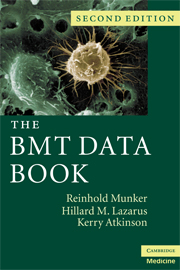Book contents
- Frontmatter
- Contents
- List of contributors
- Foreword
- Preface
- Acknowledgments
- Section 1 Basic science
- Section 2 Hematologic malignancies
- Section 3 Solid tumors
- Section 4 Nonmalignant disorders
- Section 5 Practical aspects and procedures
- Section 6 Complications
- 21 Pathobiology of graft-versus-host disease
- 22 Diagnosis and treatment of graft-versus-host-disease
- 23 Management and prophylaxis of infections after BMT/SCT
- 24 Organ-related and miscellaneous complications
- Section 7 The BMT/SCT pharmacopoeia
- Section 8 HLA-testing and laboratory medicine
- Appendix
- Index
- References
21 - Pathobiology of graft-versus-host disease
Published online by Cambridge University Press: 31 July 2009
- Frontmatter
- Contents
- List of contributors
- Foreword
- Preface
- Acknowledgments
- Section 1 Basic science
- Section 2 Hematologic malignancies
- Section 3 Solid tumors
- Section 4 Nonmalignant disorders
- Section 5 Practical aspects and procedures
- Section 6 Complications
- 21 Pathobiology of graft-versus-host disease
- 22 Diagnosis and treatment of graft-versus-host-disease
- 23 Management and prophylaxis of infections after BMT/SCT
- 24 Organ-related and miscellaneous complications
- Section 7 The BMT/SCT pharmacopoeia
- Section 8 HLA-testing and laboratory medicine
- Appendix
- Index
- References
- Type
- Chapter
- Information
- The BMT Data Book , pp. 313 - 330Publisher: Cambridge University PressPrint publication year: 2009

